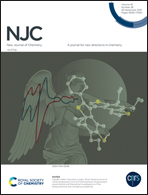Construction of LZU1@WO3 heterojunction photocatalysts: enhanced photocatalytic performance and mechanism insight
Abstract
Due to the unique structure and performance of COFs, a new well-designed nano-LZU1@WO3 composite photocatalyst was successfully synthesized through a simple hydrothermal method. The nano-LZU1@WO3 composite material shows higher photocatalytic activity than pure WO3 and LZU1 in the degradation of BBR. The best LZU10.44@WO3 showed the highest catalytic activity, removing 97.7% of BBR within 90 minutes and 97.4% MB in 110 minutes. The improved photocatalytic activity of the composite material is mainly attributed to the effective photo-generated charge separation and Z-type heterojunction transfer through the coupling between WO3 and LZU1. The composite photocatalyst showed obvious good stability and recyclability after 4 cycles. Finally, based on the active radical capture experiment and ESR, a possible Z-scheme electron transfer mechanism is proposed, which can explain the improved photocatalytic performance of the photocatalytic system. Moreover, the best hydrogen evolution for LZU10.5@WO3 reached 6133.2 μmol h−1 g−1, which is 386 times and 1.6 times that of pure WO3 and pure LZU1, respectively. We hope this work will provide a timely reference for the advancement of COF-based heterojunctions towards environmental pollutants and useful insights for future energy technologies beyond water electrolysis.



 Please wait while we load your content...
Please wait while we load your content...